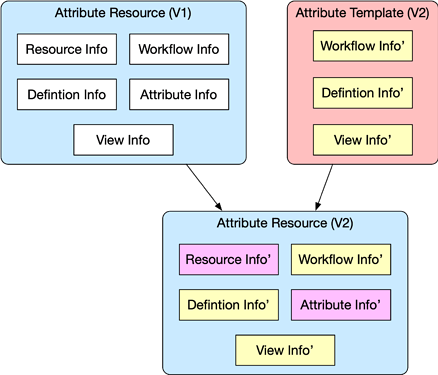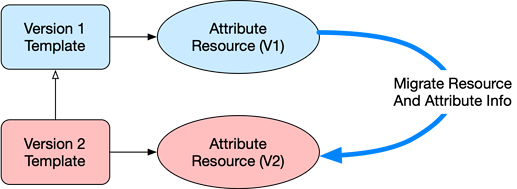The question was raised recently as to how to update an existing Attribute Resource w/r to an updated template specification. Here are some of my thoughts on the topic.
To handle the most general case where attribute producing Definitions have been replaced, refactored, or moved to other Attribute Resources, you would have to write an operator to surgically preform the update. In the case where the version updating process would effect multiple resources, I would definitely consider using a SMTK Project and write the updater to update the entire project.
Parts of an Attribute Resource
An Attribute Resource is composed of the following parts:
- SMTK Resource Information : This includes Properties assigned to the Resource as well as its UUID. Note - for brevity sake I’m also including the Resource’s active set of categories here even though this information is specific to Attribute Resources.
- Attribute Resource General Workflow Information : This information includes categories, advance levels, and analysis information
- Attribute Definition Information : This relates to the Attribute Definitions and Expression Evaluators used by the Resource and is usually initially represented by a set of XML Attribute Template files (.sbt)
- Attribute Information : This includes the Resource’s Components and represent instantiations of the Resource’s Definitions
- View Specifications : This includes the Views that are used to create the various GUI panels
What Not To Do
You can not just arbitrarily modify an Attribute Definition once attributes have been created from it. If any modification would change the structure of the attribute, you will have lots of issues including unexpected behavior and crashes.
What Can You Safely Modify w/r Attribute and Item Definitions?
Anything that does not effect the information structure of attributes. This would include:
- Defintion Labels
- Item Definition Labels
- Enumeration Strings for ValueItemDefintions
- Default Values*
- Advance Levels**
- Item Definition’s Optional Information**
- Categories***
- Analysis Configurations***
* Modifying the default value will not change Item Values that are using the current default
** Changing these may change the validity of an Attribute
*** Changes these require the Attribute Resource to rebuild some runtime information and may also result in a change in Attribute Validity
The Process of Updating To a New Version
Ground Rules
Let’s assume that we have an existing Attribute Resource that represents Version 1 of a workflow and the designer has created a Version 2 of the workflow’s template. Just to be clear I am not referring to a new version of SMTK’s File format. SMTK takes care of reading older file versions and writing out the latest version.
We then have the following situation:
Notice that three sections are not migrated at all. Workflow, Definition and View information is solely defined by the workflow designer. The migration process is focused on the Resource and Attribute Information sections as shown below:
Simplest Migration
Lets assume the following:
- The V1 Resource Information is valid for V2
- Assume that the Property values do not refer to Attributes or Definitions
- The type-names for non-abstract Attribute Definition are the same between versions and Attributes from a V1 Definition type-name are conceptually the same and those created from the V2 Definition of the same type-name
- If a V1 Attribute Definition does not exist in V2, then its is considered no longer needed and the corresponding Attributes are not to be transferred
- Item names within an Attribute have not been changed between Versions though their positions within the Attribute may be different. The same is assumed be true regarding the names of children Items within an Item.
- If an Item name in V1 does not exists in V2, then the information is considered to be no longer needed in V2.
In the above scenario, the migration procedure would consist of the following steps:
- Copy UUID and all Properties from V1 to V2
- For each Attribute a1 in V1
a. If its Definition does not exist in V2 then skip it
b. Use the Attribute Resource V2’s copyAttribute method* to create Attribute a2
* The current copyAttribute process assumes that the Attributes are coming from identical Attribute Definitions and would need the following modifications:
- Use of Item names rather than their position
- Allowing the process to proceed if an Item can not be located
Note that the above scenario would also cover the following cases:
- New Attribute Definitions
- Insertion of new Item Definitions
- Deletion of Attribute Definitions that are no longer needed
- Rearranging of Items with the same Definition
- Rearranging of Abstract Attribute Definition Hierarchy
How to generalize the process
The designer could provide a set of update scripts that is associated with the Attribute Template:
- Migration Script - if the designer wants total control of the migration process. If none is specified it assumes that the following is done:
- Migrate Resource Info
- Migrate Attribute Info
- Resource Migration Script - controls how the Properties and Active Categories get migrated to the upgraded Attribute Resource. If none is specified it assumes to simply copy all of the Properties and Active Categories
- Attribute Migration Script - controls how the Attributes get migrated, if none is specified it assumes that matching the Attribute’s Definition type-name is sufficient
- Custom Attribute Definition Migration Scripts - controls how a specific Attribute based on its Definition gets migrated. If none is specified it assumes that matching the Item names is sufficient
Issues regarding Associations
There is a question as to whether the association information can be easily transferred to the updated resource. This depends on the following questions:
Are the Prerequisites and Exclusion Information Compatible?
If the information between the version is not the same, then in which cases will it impact the association information? If the new version’s are more permissive, then what was valid based on the original Definition’s Prerequisites and Exclusions should still be valid. The check is relatively simple in that if the new version contains a subset of the original version there should be no effect. If this not true then in theory the new version will need to revalidate the associations.
What about the Definition’s Association Rules?
If the updated and original Definitions have the same association rules then once again (assume the above perquisites and exclusions are compatible) the Persistent Objects that are associated with the original attribute should be associatable with the updated version, else once again the information would beed to be reevaluated. In this case “Comparable” means the following with respects to the association rule:
- The Acceptance rules of the original version is a subset of the Acceptance rules of the update version
- The Rejection rules of the updated version is a subset of the Rejection rules of the original version.
Special Note on Handling Attributes from Definitions that have Prerequisites
If you do need to reevaluate association information, you do need to be careful if the Definition has prerequisites. A slight change in the above method could better handle this situation.
- Instead of going through all of the attributes, you will need to instead traverse all of the Definitions and then traverse all of their Attributes
- If Definition (D) has a prerequisite, it has generated attributes and has Persistent Objects associated to it, check to see if its prerequisite Definitions have Attributes in the updated version
- If the prerequisite Definition’s Attributes have not been migrated, pause D’s Attribute migration and instead migrate its prerequisite Definition first and then resume processing D. Note that the prerequisite Definition could itself have prerequisites.

